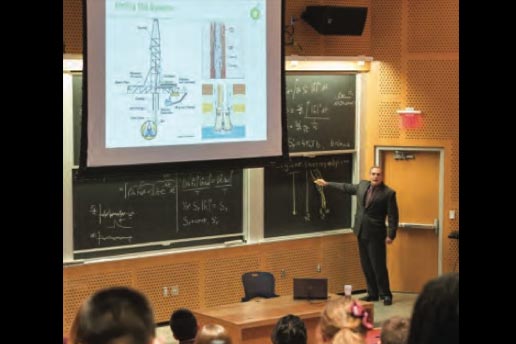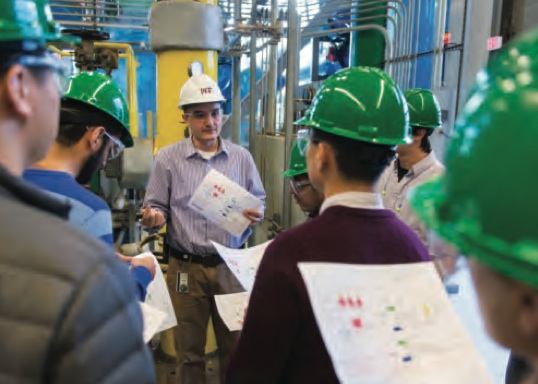
Cross-listed among six engineering departments and a mainstay of MIT’s energy minor curriculum, the class known as Introduction to Sustainable Energy (undergraduate level) or Sustainable Energy (graduate level) provides an essential survey of technologies for addressing the 21st century energy challenge. But it fulfills an even broader purpose, according to Michael Golay, lead instructor and professor of nuclear science and engineering: “I prefer to look at it as a course in critical thinking,” he says.
The class “tries to teach students how to evaluate a new energy technology and identify the challenges it must overcome,” says co-instructor William Green, the Hoyt C. Hottel Professor of Chemical Engineering. “We have students adopt the perspective of an investor, consultant, or an inventor trying to make a new product successful, and ask if the technology will make more energy than it consumes, if it can be produced at the right scale and for the right cost, and if regulatory issues might be showstoppers,” says Green, who sits on the Energy Minor Oversight Committee.
With the participation of MIT faculty from a range of disciplines, the class ponders the plausibility of energy technology solutions using multiple lenses, including economics, public policy, and science. It is an approach students appreciate.
“There is no other class at MIT where such different viewpoints can be found in one place,” says Anisha Gururaj ’15, a senior in chemical engineering and a Rhodes Scholar. “I came out of the class realizing that the energy crisis is extremely complicated in part because the different technological solutions come with their own problems,” she says.
Mechanical engineering major Catherine Fox ’15 says that learning from experts in different fields was the most valuable aspect of the class for her. “You hear a lot in the media about renewables and fossil fuels, and taking a deeper look at a range of technologies, at the calculations behind them, allowed us to debunk some of the myths.”
Launched in 1996 by Golay along with a colleague from nuclear science and engineering and three faculty and staff members from chemical engineering, the initially graduate-only class has evolved into a school-wide elective. “There was a lot of interest at the undergraduate level for a broad energy course,” says Golay. Acknowledging this demand, the MIT Energy Initiative (MITEI) stepped in to help develop an undergraduate section of the class, 22.081J, which became one of the key requirements for the Energy Studies Minor when it was launched six years ago. MITEI also has provided teaching assistant support to the class.
As a result of its broadened audience, the class enjoys high enrollment and attracts students not only from engineering departments but also from the Department of Urban Studies and Planning and the MIT Sloan School of Management. Golay notes, though, that “this is a real engineering course, not energy for poets.” Students who lack some of the engineering fundamentals “have to work harder, but they’ll get a lot of help.”
Undergraduates face engineering problem sets and exams, and graduate students taking the class must produce a case study of a new technology demonstrating analysis from a variety of perspectives. The primary text for the class is what Golay describes as an “encyclopedic book on energy, a real doorstop”—written by Golay and his colleagues. This serves as scaffolding for a sequence of sessions that begin with such basic energy topics as thermodynamics, and energy conversion and transfer (part of what Golay calls the “toolbox”); next examine energy in context; then interrogate specific energy technologies, from wind power and fusion energy to biomass, nuclear, and solar technologies; and finally look at energy end use globally, with a focus on economic and social tradeoffs.

Sustainable Energy students review a flow chart of the cogeneration of electricity and steam heat at MIT’s Central Utility Plant with plant engineer Seth Kinderman. Photo: Justin Knight
While the class includes field trips to energy-related facilities, it most prominently features a host of expert lectures by MIT researchers, many of which prove memorable for participants.
Gururaj recalls Christopher Knittel, the William Barton Rogers Professor of Energy Economics at MIT Sloan, discussing “the ethics of driving a Hummer, addressing what it means to face the social cost of something.” Fox recounts Donald Sadoway, the John F. Elliot Professor of Materials Chemistry, “hammering home the point about physics limiting current battery storage.” Both students remember the way Anne White, associate professor of nuclear science and engineering, helped them scrutinize the headline-grabbing claims made by designers of a new fusion reactor.
Instructors make it interesting for themselves, too. “We have fun going through the periodic table identifying all the elements you can make fuel out of,” says Green. “Students learn it’s hard to get away from hydrocarbons, even when you’re making something artificially.”
There also are guest lectures by industry experts. BP, a Founding Member of MITEI, participated in several sections, sending its chief bioscientist to talk about biofuels and the head of global exploration to discuss deep sea drilling. “We try to bring business realities and context that faculty may not be as conversant with,” says Andrew Cockerill, the company’s director of university relations. “We talk about how to use energy technologies at scale, and students see that there are sometimes conflicting needs in having a reliable and clean source of energy.”
The class has not remained static in content: In recent years, it has focused increasingly on climate change both because the “evidence becomes more and more conclusive,” says Golay, and because students are deeply motivated by the issue. “We tell them climate change is one of the biggest things going on in their lives, and there’s not a lot of time to figure things out.”
The class does not sugarcoat the challenge, emphasizing that while there is an urgent need to move away from fossil fuels, “there is nothing at hand that gives us a realistic prospect of doing it in the short run,” says Golay. The class offers examples of promising biofuels hung up by patent litigation and windfarms sunk by community opposition. Students come to realize, says Golay, that “the problem is not so much about technology but about organization—economic incentives, taxes, ways to amplify efforts of the private sector.” For most students, says Green, this is an entirely new way of thinking. “They come in focused on invention, but we want them to see the constraints, the rules the world operates under.”
Development of the original Sustainable Energy class was led by Golay and Jefferson Tester, then an MIT professor of chemical engineering and now professor of sustainable energy systems at Cornell University. Others who played an important role in founding the course and—with Tester and Golay—in producing two editions of the textbook were Professor Michael Driscoll of nuclear science and engineering and Drs. William Peters and Elisabeth Drake, both then affiliated with the MIT Energy Laboratory and the Department of Chemical Engineering.
This article appears in the Spring 2015 issue of Energy Futures.